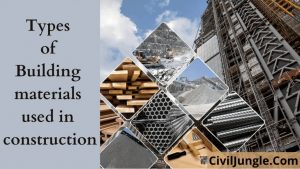Main Building Materials: A Comprehensive Guide
Introduction
When it comes to constructing buildings and structures, choosing the right building materials is crucial. The selection of materials not only impacts the overall cost but also determines the structural integrity, durability, and aesthetics of the building. In this article, we will explore the main building materials used in the construction industry and their essential properties.
1. Concrete
Overview
Concrete is one of the most widely used building materials worldwide. It is a versatile composite material made by mixing cement, water, aggregates (such as sand, gravel, or crushed stone), and sometimes additives for specific purposes. Concrete is known for its excellent compressive strength, making it ideal for foundations, walls, and floors.
Advantages
High compressive strength
Cost-effective
Fire-resistant
Durable and long-lasting
Low maintenance
Disadvantages
Relatively low tensile strength
Prone to cracking under tension
Heavy and requires substantial support during construction
2. Steel
Overview
Steel is a vital building material known for its exceptional strength and versatility. It is an alloy of iron and carbon, with small amounts of other elements to enhance its properties. Steel is commonly used in various building components, including beams, columns, and reinforcement bars.

Advantages
High tensile strength
Ductile and flexible
Faster construction due to pre-fabrication options
Recyclable and environmentally friendly
Resistant to pests and decay
Disadvantages
Susceptible to corrosion, requiring proper surface treatments
Higher initial cost compared to some other materials
Significant heat conductivity may lead to thermal bridging if not addressed
3. Brick
Overview
Brick, made from clay through a firing process, has been used as a building material for thousands of years. It comes in various shapes, sizes, and colors, allowing for diverse architectural designs. Bricks are commonly used in walls, facades, and pavements.
Advantages
Excellent compressive strength
Provides good insulation against heat and noise
Fire-resistant
Low maintenance and long-lasting
Environmentally friendly, made from natural materials
Disadvantages
Poor tensile strength
Heavy and may require additional support
Labor-intensive installation process
Limited design flexibility compared to some other materials
4. Wood
Overview
Wood, a traditional building material, offers unique aesthetics and natural beauty. It is commonly used in residential construction, particularly for interior elements and structural framing.
Advantages
Renewable and sustainable
Good thermal and acoustic insulation
Lightweight and easy to work with
Aesthetically pleasing and enhances interior warmth
Carbon neutral when sourced responsibly
Disadvantages
Susceptible to pests and decay without proper treatment
Lower fire resistance compared to some other materials
Dimensional changes due to moisture content fluctuations
Limited use in tall or large-scale buildings
5. Glass
Overview
Glass is a transparent material made primarily from sand and soda-lime. It is a unique building material used extensively for windows, facades, and decorative purposes.

Advantages
Provides natural light and enhances aesthetics
Resistant to pests and decay
Recyclable and eco-friendly
Various types available, including energy-efficient options
Low maintenance and easy to clean
Disadvantages
Brittle and prone to breakage
Limited insulation properties, leading to potential heat loss
Higher cost for specialized or energy-efficient glass types
Requires careful installation to ensure proper sealing and prevent leaks
Conclusion
Selecting the right building materials is vital for any construction project. Concrete, steel, brick, wood, and glass are just a few of the main building materials used in the industry, each offering distinct advantages and disadvantages. The choice of materials should consider factors such as structural requirements, climate conditions, budget, and sustainability goals. https://citibuildconstruction.com.au/builder-vaucluse/
By understanding the properties and characteristics of these main building materials, architects, engineers, and construction professionals can make informed decisions, ensuring the successful completion of durable, safe, and aesthetically pleasing structures that stand the test of time.
